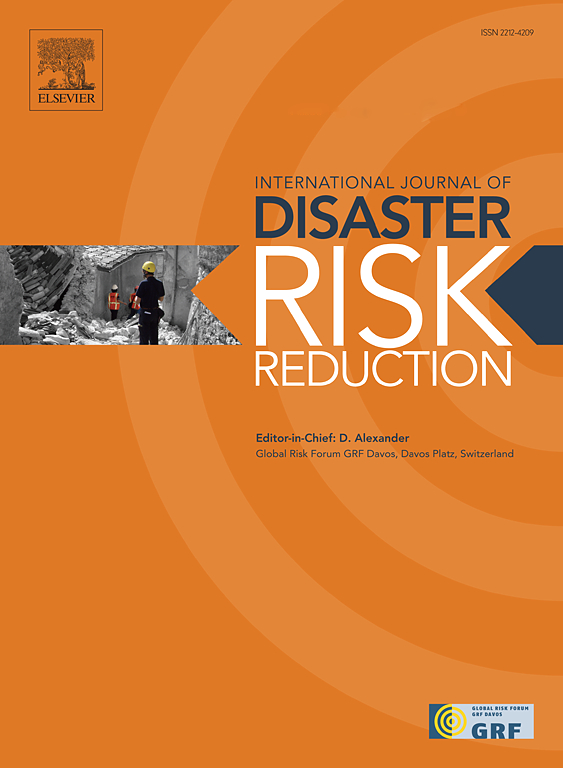基于遥感影像的地震建筑结构类型估计实例分割技术——来自中国西安市的证据
IF 4.5
1区 地球科学
Q1 GEOSCIENCES, MULTIDISCIPLINARY
International journal of disaster risk reduction
Pub Date : 2025-07-10
DOI:10.1016/j.ijdrr.2025.105686
引用次数: 0
摘要
收集地震风险评估的暴露信息往往是一项劳动密集型和昂贵的工作。本研究揭示了利用遥感图像和实例分割模型自动确定地震建筑结构类型(SBSTs)的潜力。介绍了一个全面的过程,其中包括:(i)从遥感图像获取数据;(ii)为后续的监督模型学习编译训练数据,包括裁剪、调整大小、零填充、标记和增强;(iii)和使用YOLO系列的监督模型学习。对于后者,我们实现了一组来自YOLOv5、v7、v8和v11的17个预训练模型,并提供了详尽的实验评估。以西安古城墙为研究区域,基于古城墙内的建筑来评价模型的分类精度。研究结果如下:相对较大的模型大小和更好的模型对任务的适应性使得YOLOv7x-seg在实例分割方面的性能更好,使得YOLOv7x-seg优于其他模型。通过比较,高度和材料实例分割等单一任务的平均精度值优于综合任务,即SBST实例分割,效率从SBST到高度,最后到材料。从应用的角度来看,这些模型可以有效地识别各种城市布局中的建筑,包括开放场景中的建筑、规则排列的建筑以及密集、不规则排列的建筑。然而,这些模型仍然偶尔会出现漏检或误报的情况。然而,我们的工作强调了在复杂建筑环境中快速评估关键地震暴露特性的巨大潜力。本文章由计算机程序翻译,如有差异,请以英文原文为准。
Instance segmentation techniques for seismic building structural type estimation from remote sensing imagery – Evidence from Xi'an city, China
Collecting exposure information for seismic risk assessment if frequently a labor-intensive and costly aspect. This study reveals the potential of automatically determining Seismic Building Structure Types (SBSTs) utilizing remote sensing imagery and instance segmentation models. A comprehensive process is introduced, which encompasses (i) data acquisition from remote sensing imagery; (ii) compilation of training data for subsequent supervised model learning, including clipping, resizing, zero-padding, labeling, and augmentation; (iii) and supervised model learning using the YOLO Series. Regarding the latter, we implement a set of seventeen pretrained models from YOLOv5, v7, v8 and v11 and provide an exhaustive experimental evaluation. The ancient Xi'an city wall is employed as the research area to evaluate the models' classification accuracy based on the buildings within it. The findings are as follows: A relatively larger model size and better adaptability of the model to the task lead to better performance in instance segmentation, allowing YOLOv7x-seg to outperform other models. By comparison, the mean average precision value for singular tasks, such as height and material instance segmentation, surpasses that of the comprehensive task, i.e., SBST instance segmentation, with effectiveness increasing from SBST, to height, and finally, to material. From an application standpoint, the models effectively identify buildings across various urban layouts, including buildings in open scenes, regularly arranged structures, and dense, irregularly arranged developments. However, the models still occasionally exhibit instances of missed detections or false positives. Nevertheless, our work underlines the great potential for a rapid assessment of crucial seismic exposure properties in complex built environments.
求助全文
通过发布文献求助,成功后即可免费获取论文全文。
去求助
来源期刊

International journal of disaster risk reduction
GEOSCIENCES, MULTIDISCIPLINARYMETEOROLOGY-METEOROLOGY & ATMOSPHERIC SCIENCES
CiteScore
8.70
自引率
18.00%
发文量
688
审稿时长
79 days
期刊介绍:
The International Journal of Disaster Risk Reduction (IJDRR) is the journal for researchers, policymakers and practitioners across diverse disciplines: earth sciences and their implications; environmental sciences; engineering; urban studies; geography; and the social sciences. IJDRR publishes fundamental and applied research, critical reviews, policy papers and case studies with a particular focus on multi-disciplinary research that aims to reduce the impact of natural, technological, social and intentional disasters. IJDRR stimulates exchange of ideas and knowledge transfer on disaster research, mitigation, adaptation, prevention and risk reduction at all geographical scales: local, national and international.
Key topics:-
-multifaceted disaster and cascading disasters
-the development of disaster risk reduction strategies and techniques
-discussion and development of effective warning and educational systems for risk management at all levels
-disasters associated with climate change
-vulnerability analysis and vulnerability trends
-emerging risks
-resilience against disasters.
The journal particularly encourages papers that approach risk from a multi-disciplinary perspective.
 求助内容:
求助内容: 应助结果提醒方式:
应助结果提醒方式:


